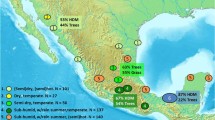Summary
Background
Recent reports have suggested that exposure to high pollen counts can be life-threatening, not only for allergics, but also for patients with heart and lung diseases.
Patients and methods
This study evaluated the prevalence of asthma and rhinitis due to pollen allergy, particularly to grass pollen, in a randomized sample of the general population of Perugia, Italy. 1,048 subjects aged 3–69 years answered a modified version of the American Thoracic Society and National Heart and Lung Institute (ATS-DLD-78) questionnaire and 796 subjects (76% of the sample) underwent skin prick tests with eight common aeroallergens (grass, Parietaria, olive, cypress, house dust mite, cat, dog and rabbit dander).
Results
The prevalence of current asthma or rhinitis was 5.1% or 14.3%, respectively. Positive skin tests were found in 21.9% of asymptomatic subjects, in 58.0% of asthmatic and in 65.0% of rhinitic subjects. Sensitization to grass was present in 46.0% of individuals with positive skin tests, in 62.0% of patients with allergic asthma, and in 58.0% of those with allergic rhinitis. In the 79 subjects who were sensitized to grass the prevalence of asthma and rhinitis increased fourfold compared with the overall prevalence. Symptoms of rhinitis developed before those of asthma in nearly 2/3 of cases with the two diseases, starting simultaneously in the others. The spring symptoms tended to start in March or April in rhinitic and asthmatic subjects, and peaked in May for rhinitis and in June for asthma.
Conclusions
In this study we confirmed grass pollen as the primary cause of respiratory allergy in central Italy and provided indirect evidence that different threshold concentrations of grass pollen could influence the onset of asthma and/or rhinitis in allergic subjects.
Zusammenfassung
Hintergrund
Aktuelle Veröffentlichungen legen die Vermutung nahe, dass hohe Pollenkonzentrationen nicht nur für Allergiker, sondern auch für Patienten mit Herz- und Lungen-Erkrankungen lebensbedrohlich sein können.
Patienten und Methoden
Wir untersuchten die Prävalenz von Asthma und Rhinitis bei Pollen-Allergie, insbesondere auf Gräserpollen, in einer randomisierten Stichprobe der Allgemeinbevölkerung von Perugia, Italien. Es wurden 1.048 Personen (Alter: 3–69 Jahre) mittels eines modifizierten Fragebogens (ATS-DLD-78) der „American Thoracic Society“ und des „National Heart and Lung Institute“ befragt. Bei 796 Studienteilnehmern (76% der Stichprobe) führten wir Prick-Tests mit acht häufigen Aero-Allergenen durch.
Ergebnisse
Die Prävalenz von Asthma bronchiale bzw. Rhinitis war 5,1% bzw. 14,3%. Der Hauttest fiel bei 21,9% der asymptomatischen Probanden, bei 58,0% der Asthma-Patienten und bei 65,0% derjenigen mit allergischer Rhinitis positiv aus. Eine Sensibilisierung gegenüber Gräserpollen zeigte sich bei 46,0% der Probanden mit positivem Pricktest, bei 62,0% der Asthma- und bei 58,0% der Rhinitis-Patienten. Bei Personen mit einer Sensibilisierung gegenüber Gräserpollen war die Prävalenz von Asthma und Rhinitis vierfach höher als in der Gesamtpopulation. Zwei Drittel der Patienten mit Rhinitis und Asthma litten zuerst an Rhinitis und erst später an Asthma, bei einem Drittel traten beide Erkrankungen gleichzeitig in Erscheinung. Die Frühjahrsbeschwerden begannen im März/April und erreichten bei Rhinitis im Mai und bei Asthma im Juni ihren Höhepunkt.
Schlussfolgerungen
Diese Studie bestätigt, dass Gräserpollen die Hauptursache allergischer Erkrankungen der Atemwege in Zentral-Italien sind. Zudem lieferte sie Hinweise, dass unterschiedliche Gräserpollen-Konzentrationen den Beginn der asthmatischen bzw. rhinitischen Symptome beeinflussen können.
Similar content being viewed by others
Author information
Authors and Affiliations
Rights and permissions
About this article
Cite this article
Siracusa, A., Marabini, A., Polticchia, M.S. et al. Epidemiology of asthma and rhinitis due to grass pollen allergy. Allergo J 10, 456–458 (2001). https://doi.org/10.1007/BF03360859
Revised:
Accepted:
Published:
Issue Date:
DOI: https://doi.org/10.1007/BF03360859




